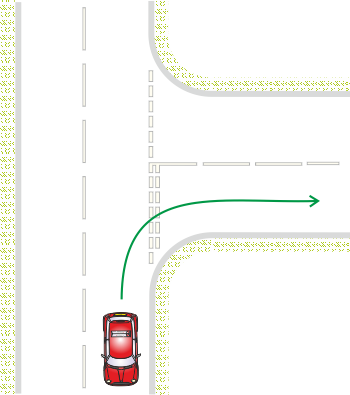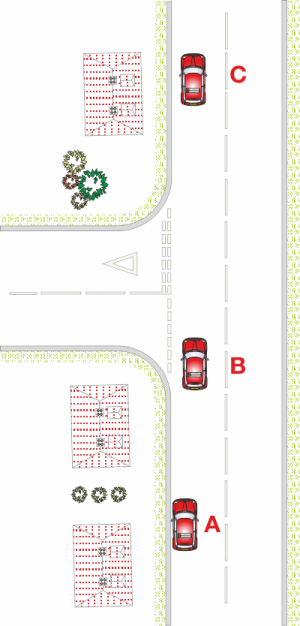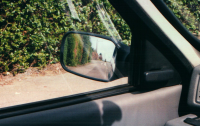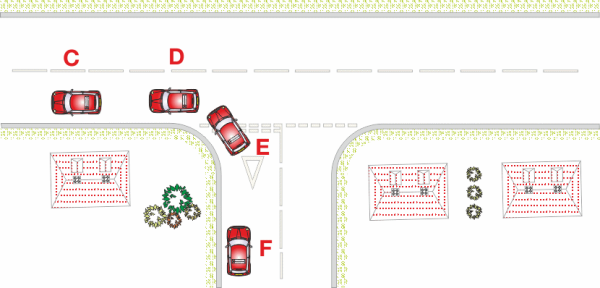
In December 2017, this manoeuvre was removed from the UK driving test - after 82 years!
Even though it's no longer in the test, it's still worth reading this page and learning the manoeuvre - as much as anything to discover safe places to reverse. But to also know that it can be a valuable skill when you need to turn around, and it's the only option.
 The left reverse skills are also valuable for reversing into gateways, garages, driveways or anywhere else where you need slow-speed reversing skills. The more flexibility you can build into your reversing, the better prepared you will be for the manoeuvres included in the driving test.
The left reverse skills are also valuable for reversing into gateways, garages, driveways or anywhere else where you need slow-speed reversing skills. The more flexibility you can build into your reversing, the better prepared you will be for the manoeuvres included in the driving test.
Although no longer the driving test, reversing left is still in the DVSA recommended syllabus for learning to drive.
When doing this exercise, as with all slow-speed manoeuvres, you will be the odd one out on the road, going against the traffic flow. This means that you must be fully aware of what is happening all around, all the time.
Your 'OWL-like' observation (from the straight-line reversing lesson) is especially important during this manoeuvre to see pedestrians who might cross behind your vehicle or other vehicles that might be approaching.
When you have mastered the skills in this lesson, you will be able to reverse safely into a side road on the left using proper observation, under full control and with reasonable accuracy.
IMPORTANT NOTE: While we suggest that you should learn this manoeuvre you don't need 'pin-point' accuracy, You simply need to be able to steer around the corner and then reverse in a straight line. This should tale no more than 10 minutes to master as long as you do it a the right time. A couple of weeks before your driving test is a good time to learn.
There is no quiz for this lesson.
For over 35 3D briefing videos visit Driving test Success. (Google Play | App Store - appstore practical videos available as an in app purchase in the 4 in 1 kit)
You probably won't use this skill to reverse from one road to another very often. You are more likely to reverse into gateways or similar openings. But wherever you reverse the observation and safety considerations in this lesson are essential.
As with all driving manoeuvres, you must make sure you choose a safe, convenient, legal position to reverse.
Safe means that you must not endanger yourself or others.
Legal means that you must not infringe any laws or drive carelessly or dangerously.
Convenient means that you must not cause undue inconvenience to others - remember, you are the 'odd one out' when manoeuvring.
With this in mind, avoid busy junctions, crossroads, schools, or places where there might be a lot of pedestrian or traffic activity.
You need to have full control, good observation and reasonable accuracy. This typically means you will drive very slowly (zimmer frame speed!) In a manual car, use clutch-control. In electric or automatic vehicles, use the method that suits you best to keep the car slow and under control. (This might or might not involve left-foot braking.)
These notes explain how to reverse into a side road - this is the easiest way to learn and practise the left reverse.
In everyday driving, you will probably start the reverse at point 'C' (on the diagram) after having driven past the gateway (or wherever) and checked to ensure that it is clear and safe to reverse. It's always important to check - for example, there are often kids or pets on driveways.
When you practise this exercise, your instructor will probably get you to pull up at point 'A' so they can explain what you need to do.

It's essential to complete your usual safety checks before moving off from point 'A' - this might seem obvious. However, when focusing on the reverse manoeuvre, it is easy to fall into the trap of overlooking the obvious.
Make sure that you don't have problems on the test, or at any other time, by using the POM routine every time you move off before any manoeuvre (click here for a reminder of observation during the routine).
Because you will be stopping almost immediately after moving off from point 'A' (at point 'C') you might also need a longer gap in traffic to avoid the risk of causing problems for drivers approaching from behind.
Glance into the side road (or opening) to ensure it is clear.
Is there enough space to reverse?
Will it be safe to complete the manoeuvre?
When reversing into a side road, you are looking for road works, parked cars, skips, etc., that might prevent you from reversing. It's not only fixed obstructions that might cause a problem. For example, how might children playing on the footpath affect you?
After you have checked that the side road is clear, use your MSM routine to stop safely at point 'C'.
Check your mirrors and give a signal (if required*), then stop about two or three car lengths beyond the corner, approximately 45cm from the kerb.
You are stopping further from the kerb than when parking because you need space to reverse. If you are too close to the edge of the road, you risk bumping the kerb and damaging your tyres.
*If you need a signal, be careful about the timing so that you don't mislead people into thinking that you are turning left.

Before starting to reverse from point 'C' (see the diagram below), make sure that the road is clear, especially the left and right blind spots, and that you are looking back, well behind the car, before you start to move.
Give way to other traffic - remember that when reversing, you are the 'odd one out'.
For the first part of the reverse, drive back in a straight line until you get to Point 'D'.
Check the road to the rear before starting to turn the wheel. Also, because the front of the car will swing out as you turn, you must check to the front to ensure the road is clear.
The shape of the corner will determine the amount you turn the wheel. The best way to learn is usually 'trial and error'.

As you drive around the corner, make frequent checks all around, you may need to pause occasionally to do this.
You can use the nearside door mirror or a rear-view camera but only take quick glances. If you 'stare' at the mirror or camera, you might not see things on the road - for example, you might not see a child who runs out behind your car before it's too late.
This only applies if you are reversion into a side road.
Keep looking behind until the car comes to a stop. The easiest way to finish in a straight line is to judge your position by looking well back along the road - if another vehicle is parked further back, you can line up with it.
